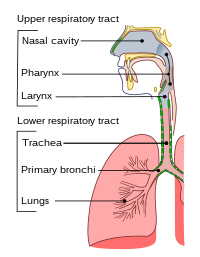
Photo from wikipedia
Objective Internal jugular vein puncture or cannulation is far more difficult in children compared with adults. Anthropometric measures of the internal jugular vein acquired by two-dimensional ultrasound are useful in… Click to show full abstract
Objective Internal jugular vein puncture or cannulation is far more difficult in children compared with adults. Anthropometric measures of the internal jugular vein acquired by two-dimensional ultrasound are useful in the practice of puncture and catheterization. The aim of this study is to measure anthropometric parameters of bilateral internal jugular veins in children and to determine the best puncture site based on these parameters. Materials A total of 107 pediatric patients undergoing elective operation were included. Ultrasound-visible evaluation of bilateral internal jugular veins was used to obtain the depth from skin, maximum antero-posterior diameter, and cross-sectional area at the levels of the superior border of thyroid cartilage and cricoid cartilage. Statistical analysis was performed using these anthropometric data and demographic variables of all studied pediatric patients, such as age, height, and weight. Results A very weak correlation was noted between the depth, maximal antero-posterior diameter, and cross-sectional area of both internal jugular veins and the age, height, weight, and body surface index of all included children. All Pearson's R correlation coefficients were <0.45. The largest diameter and cross-sectional area were in the right internal jugular vein at the cricoid cartilage level (p < 0.01) followed by the left internal jugular vein at this level (p < 0.01). In addition, the internal jugular vein at the cricoid cartilage level was more superficial than that of the superior border of the thyroid cartilage (p < 0.01). Conclusion The right internal jugular vein at the cricoid cartilage level is the best site for puncture. The most appropriate alternative site is the left internal jugular vein on the same level. Better correlation was not observed between the anthropometric parameters of the internal jugular vein and children's biological characteristics. This finding should be confirmed in a larger-scale demographical study in the future.
Journal Title: Frontiers in Pediatrics
Year Published: 2022
Link to full text (if available)
Share on Social Media: Sign Up to like & get
recommendations!